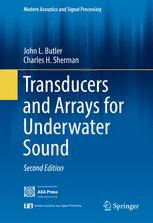Table Of ContentModern Acoustics and Signal Processing
John L. Butler
Charles H. Sherman
Transducers
and Arrays for
Underwater
Sound
Second Edition
Modern Acoustics and Signal Processing
Editor-in-Chief
WilliamM.Hartmann,EastLansing,USA
EditorialBoard
YoichiAndo,Kobe,Japan
WhitlowW.L.Au,Kane’ohe,USA
ArthurB.Baggeroer,Cambridge,USA
NevilleH.Fletcher,Canberra,Australia
ChristopherR.Fuller,Blacksburg,USA
WilliamA.Kuperman,LaJolla,USA
JoanneL.Miller,Boston,USA
AlexandraI.Tolstoy,McLean,USA
More information about this series at http://www.springer.com/series/3754
The ASA Press
TheASAPressimprintrepresentsacollaborationbetween theAcousticalSociety
ofAmericaandSpringerdedicatedtoencouragingthepublicationofimportantnew
booksinacoustics.Publishedtitlesareintendedtoreflectthefullrangeofresearch
inacoustics.ASAPressbookscanincludealltypesofbookspublishedbySpringer
andmayappearinanyappropriateSpringerbookseries.
EditorialBoard
JamesCottingham(Chair),CoeCollege
DianaDeutsch,UniversityofCalifornia,SanDiego
TimothyF.Duda,WoodsHoleOceanographicInstitution
RobinGlosemeyerPetrone,ThresholdAcoustics
MarkF.Hamilton,UniversityofTexasatAustin
WilliamM.Hartmann,MichiganStateUniversity
JamesF.Lynch,WoodsHoleOceanographicInstitution
PhilipL.Marston,WashingtonStateUniversity
ArthurN.Popper,UniversityofMaryland
MartinSiderius,PortlandStateUniversity
AndreaM.Simmons,BrownUniversity
NingXiang,RensselaerPolytechnicInstitute
WilliamYost,ArizonaStateUniversity
John L. Butler • Charles H. Sherman
Transducers and Arrays
for Underwater Sound
Second Edition
JohnL.Butler CharlesH.Sherman
ChiefScientist ImageAcoustics,Inc.
ImageAcoustics,Inc. Cohasset,MA,USA
Cohasset,MA,USA
ISSN2364-4915 ISSN2364-4923 (electronic)
ModernAcousticsandSignalProcessing
ISBN978-3-319-39042-0 ISBN978-3-319-39044-4 (eBook)
DOI10.1007/978-3-319-39044-4
LibraryofCongressControlNumber:2016943832
©SpringerInternationalPublishingSwitzerland2007,2016
Thisworkissubjecttocopyright.AllrightsarereservedbythePublisher,whetherthewholeorpartof
the material is concerned, specifically the rights of translation, reprinting, reuse of illustrations,
recitation, broadcasting, reproduction on microfilms or in any other physical way, and transmission
or information storage and retrieval, electronic adaptation, computer software, or by similar or
dissimilarmethodologynowknownorhereafterdeveloped.
The use of general descriptive names, registered names, trademarks, service marks, etc. in this
publicationdoesnotimply,evenintheabsenceofaspecificstatement,thatsuchnamesareexempt
fromtherelevantprotectivelawsandregulationsandthereforefreeforgeneraluse.
Thepublisher,theauthorsandtheeditorsaresafetoassumethattheadviceandinformationinthis
book are believed to be true and accurate at the date of publication. Neither the publisher nor the
authors or the editors give a warranty, express or implied, with respect to the material contained
hereinorforanyerrorsoromissionsthatmayhavebeenmade.
Printedonacid-freepaper
ThisSpringerimprintispublishedbySpringerNature
TheregisteredcompanyisSpringerInternationalPublishingAGSwitzerland
Acoustical Society of America
ThemissionoftheAcousticalSocietyofAmerica(www.acousticalsociety.org)is
to increase and diffuse the knowledge of acoustics and promote its practical
applications.TheASAisrecognizedastheworld’spremierinternationalscientific
societyinacoustics,andcountsamongitsmorethan7,000members,professionals
in the fields of bioacoustics, engineering, architecture, speech, music, oceanogra-
phy,signalprocessing,soundandvibration,andnoisecontrol.
Sinceitsfirstmeetingin1929,TheAcousticalSocietyofAmericahasenjoyeda
healthygrowthinmembershipandinstature.Thepresentmembershipofapprox-
imately 7,500 includes leaders in acoustics in the United States of America and
other countries. The Society has attracted members from various fields related to
soundincludingengineering,physics,oceanography,lifesciences,noiseandnoise
control,architecturalacoustics;psychologicalandphysiologicalacoustics;applied
acoustics; music and musical instruments; speech communication; ultrasonics,
radiation, and scattering; mechanical vibrations and shock; underwater sound;
aeroacoustics; macrosonics; acoustical signal processing; bioacoustics; and many
moretopics.
To assure adequate attention to these separate fields and to new ones that may
develop,theSocietyestablishestechnicalcommitteesandtechnicalgroupscharged
with keeping abreast of developments and needs of the membership in their
specialized fields. This diversity and the opportunity it provides for interchange
ofknowledgeandpointsofviewhasbecomeoneofthestrengthsoftheSociety.
The Society’s publishing program has historically included the Journal of the
Acoustical Society of America, the magazine Acoustics Today, a newsletter, and
variousbooksauthoredbyitsmembersacrossthemanytopicalareasofacoustics.
Inaddition,ASAmembersareinvolvedinthedevelopmentofacousticalstandards
concernedwithterminology,measurementprocedures,andcriteriafordetermining
theeffectsofnoiseandvibration.
Series Preface for Modern Acoustics and Signal Processing
Inthepopularmind,theterm“acoustics”referstothepropertiesofaroomorother
environment—the acoustics of a room are good or the acoustics are bad. But as
understoodintheprofessionalacousticalsocietiesoftheworld,suchasthehighly
influentialAcousticalSocietyofAmerica,theconceptofacousticsismuchbroader.
Of course, it is concerned with the acoustical properties of concert halls, class-
rooms, offices, and factories—a topic generally known as architectural acoustics,
butitisalsoconcernedwithvibrationsandwavestoohighortoolowtobeaudible.
Acousticians employ ultrasound in probing the properties of materials, or in
medicine for imaging, diagnosis, therapy, and surgery. Acoustics includes
infrasound—the wind-driven motions of skyscrapers, the vibrations of the earth,
andthemacroscopicdynamicsofthesun.
Acousticsstudiestheinteractionofwaveswithstructures,fromthedetectionof
submarinesintheseatothebuffetingofspacecraft.Thescopeofacousticsranges
from the electronic recording of rock and roll and the control of noise in our
environmentstotheinhomogeneousdistributionofmatterinthecosmos.
Acousticsextendstotheproductionandreceptionofspeechandtothesongsof
humans and animals. It is in music, from the generation of sounds by musical
instruments to the emotional response of listeners. Along this path, acoustics
encounters the complex processing in the auditory nervous system, its anatomy,
genetics,andphysiology—perceptionandbehavioroflivingthings.
Acoustics is a practical science, andmodern acoustics is so tightly coupled to
digital signal processing that the two fields have become inseparable. Signal
processing is not only an indispensable tool for synthesis and analysis but it also
informsmanyofourmostfundamentalmodelsabouthowacousticalcommunica-
tionsystemswork.
Given the importance of acoustics to modern science, industry, and human
welfareSpringerpresentsthisseriesofscientificliterature,entitledModernAcous-
tics and Signal Processing. This series of monographs and reference books is
intended to cover all areas of today’s acoustics as an interdisciplinary field. We
expect that scientists, engineers, and graduate students will find the books in this
seriesusefulintheirresearch,teaching,andstudies.
WilliamM.Hartmann
To Nancy
Preface to Second Edition
This second edition presents the theory and practice of underwater sound electro-
acoustic transducers and arrays as developed during the last half of the twentieth
centuryandintotheinitialpartofthetwenty-firstcentury.Thissecondeditionhas
beenreorganizedintoaformsuitableforstudentsaswellasengineersorscientists
who use or design transducers and arrays and includes new design concepts,
analysis,anddata.
Comprehensive coverage is presented on the subject of transducers and arrays
forunderwatersound.Themostimportantbasicconceptsofelectroacoustictrans-
duction are introduced in Chap. 1, after a brief historical review and a survey of
some ofthe manyapplications of transducers and arrays. Chapter2describesand
compares the six major types of electroacoustic transducers, presents additional
transducer concepts and characteristics, and introduces the equivalent circuit
method of transducer analysis. Chapter 3 describes the principal methods of
transducer modeling, analysis, and design, including an introduction to the finite
element method. Chapter 4 gives further discussion of the most important trans-
ducercharacteristics.
Chapters5–8containthemainbodyofresultsonmoderntransducersandarrays.
Chapters5and6covertransducersasprojectors,whichproducesound,andtrans-
ducers as hydrophones, which receive sound, including many details of specific
transducerdesignsastheyareusedincurrentapplicationsaswellasnewdesigns.
Chapters7and8explainthebenefitsofcombininglargenumbersoftransducersin
arraysthatoftencontainhundredsofindividualtransducers.Theselargearraysare
necessary in many sonar applications, but they introduce other problems that are
also discussed and analyzed. Chapter 9 is a summary of the major methods of
measurementusedfortheevaluationoftransducerandarrayperformance.
Chapter 10 presents the basic acoustics concepts and analysis necessary for
determining those acoustical quantities, such as directivity patterns and radiation
impedance,whichareessentialtotransducerandarrayanalysisanddesign.Italso
includes useful results for such quantities in several typical cases. Chapter 11
extends the discussion of acoustical quantities by introducing more advanced
ix

